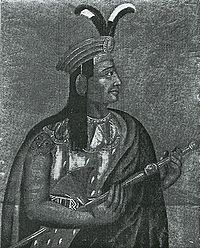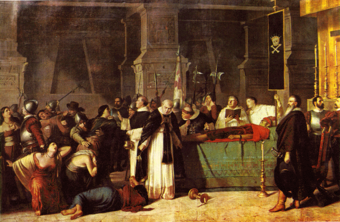Atahualpa
| Atahualpa | |
|---|---|
| Sapa Inca | |
 |
|
| Reign | 1532 – July 26, 1533 |
| Quechua | Atawallpa |
| Born | March 20, 1497 |
| Birthplace | Caranqui, Ecuador |
| Died | July 26, 1533 |
| Place of death | Cajamarca |
| Buried | Cajamarca, July 25, 1533 |
| Predecessor | Huayna Capac |
| Successor | Túpa Huallpa |
| Consort | Asarpay |
| Dynasty | Hanan Cuzco |
| Father | Huayna Cápac |
| Mother | Ñusta Pacha |
Atahualpa, Atahuallpa, Atabalipa, or Atawallpa (March 20, 1497 Caranqui, Ecuador – Cajamarca, July 26, 1533), was the last Sapa Inca or sovereign emperor of the Tahuantinsuyu, or the Inca Empire. Born in what is now Caranqui, Ecuador, Atahualpa was the offspring of Inca Huayna Capac and Pacha Duchicela, a Quiteña princess and first-born of Cacha Duchicela.[1] The union was a politically expedient one, as the southern Ecuadorian Andies had been conquered by Inca Huayna Capac's father, Inca Tupac-Yupanqui some years earlier, and there being still elements of revolt among the people. As an adult, Atahualpa became emperor upon defeating his older half-brother Huáscar in a civil war sparked by the death of their father, Inca Huayna Capac, from an infectious disease which may have been smallpox.[2] During the Spanish conquest of the Inca Empire, the Spaniard Francisco Pizarro crossed his path, captured Atahualpa, and used him to control the Inca empire. Eventually, the Spanish executed Atahualpa by garrote, ending the Inca Empire (although several successors claimed the title of Sapa Inca ("unique Inca") and led a resistance against the invading Spaniards). After Atahualpa died, the Incan Empire began to fall apart.
Contents |
Civil war
Huáscar, who was not a warrior by nature, sent to Tumipampa the great southern army under the command of General Atoc to persuade Atahualpa to lay down his arms. Huáscar and Atahualpa's armies first encountered each other on the Plain of Chillopampa.[3] Atahualpa was captured after the battle but fled from captivity with the help of a native young girl and rejoined his generals Chalicuchima, Rumiñahui, and Quizquiz. He gathered an army and defeated Huáscar's army at the battle of Chimborazo. General Atoc was taken prisoner and fell victim to the cruelties of Chalicuchima who, according to one source, had a gold incrusted chicha cup made out of Atoc's skull, and used the bottom of his feet's skin for drums. Atahualpa pressed onward and began to conquer the rest of the empire, including the town of Tumebamba, whose citizens he punished in gruesome ways for supporting Huáscar at the beginning of the civil war.
The final battle took place at Quipaipan, where Huáscar was captured and his army disbanded. Atahualpa had stopped in the city of Cajamarca in the Andes with his army of about 80,000 troops on his way south to Cusco to claim his throne when he encountered the Spanish led by Pizarro.
Spanish conquest
In January 1531, a Spanish expedition landed on what is now the northern coast of Ecuador; led by Francisco Pizarro, it comprised 180 men and 37 horses on a quest to conquer the Inca Empire.[4] The Spaniards advanced to the south and occupied Tumbes where they found out about the civil war between Huascar and Atahualpa.[5] After receiving reinforcements, Pizarro founded the city of San Miguel de Piura in September 1532 and then marched towards the heart of the Inca Empire with a force of 106 foot-soldiers and 62 horsemen.[6] At that time, Atahualpa and his army were in Cajamarca; on hearing about the party of strangers advancing through the empire he sent an Inca noble to investigate them.[7] This envoy stayed for two days in the Spanish camp, studied the weapons and horses, and delivered an invitation to visit Cajamarca to meet Atahualpa.[8] It seems Atahualpa did not consider the small Spanish force as a threat so he let them march to his encounter to capture them personally; thus, Pizarro and his men advanced unopposed through some very difficult terrain, arriving to Cajamarca on November 15, 1532.[9]
The town of Cajamarca was mostly empty except for a few hundred acllas; the Spaniards occupied long buildings on the main plaza. Atahualpa and his army had camped on a hill close to Cajamarca; he occupied a building close to the Konoj hot springs while his soldiers had erected numerous tents around him.[10] Pizarro sent an embassy to the Inca, led by Hernando de Soto with 15 horsemen and an interpreter; shortly thereafter he sent 20 more horsemen led by his brother Hernando Pizarro as reinforcements in case of an Inca attack.[11] During the interview, the Spaniards invited Atahualpa to visit Cajamarca to meet Francisco Pizarro; the Inca promised to go the following day.[12] In the town, Pizarro prepared an ambush to trap the Inca: the Spanish cavalry and infantry occupied three long buildings around the plaza, while some musketeers and four pieces of artillery were located in a stone structure in the middle of the square.[13] The plan was to persuade Atahualpa to submit to the authority of the Spaniards and, if this failed, there were two options: a surprise attack if success seemed possible or to keep a friendly stand if the Inca forces appeared too powerful.[14]
The following day, Atahualpa left his camp at midday preceded by a large number of men in ceremonial attire; as the procession advanced slowly, Pizarro sent his brother Hernando to invite the Inca to enter Cajamarca before nightfall.[15] Atahualpa entered the town late in the afternoon in a litter carried by eighty lords; with him there were four other lords in litters and hammocks and five or six thousand men carrying small battle axes, slings and pouches of stones underneath their clothes.[16] The Inca found no Spaniards in the plaza as they were all inside the buildings—the only one to come out was the Dominican friar Vincente de Valverde with an interpreter.[17] Even though there are different accounts on what Valverde said, most agree that he invited the Inca to come inside to talk and dine with Pizarro but Atahualpa did not agree and instead demanded the return of every single thing the Spaniards had taken since they landed.[18] According to eyewitness accounts, Valverde then spoke about the Catholic religion but did not deliver the requerimiento, a speech requiring the listener to submit to the authority of the Spanish Crown and accept Catholicism.[19] At Atahualpa's request, Valverde gave him his breviary but after a brief examination the Inca threw it to the ground; Valverde then hurried back towards Pizarro, calling on the Spaniards to attack.[20] At that moment, Pizarro gave the signal to attack; the Spanish infantry and cavalry came out of their hiding places and charged the unsuspecting Inca retinue, killing a great number while the rest fled in panic.[21] Francisco Pizarro led the attack on Atahualpa but only managed to capture him after killing all those carrying him and turning over his litter.[22]
Prison and execution

On November 17 the Spaniards sacked the Inca army camp in which they found great quantities of gold, silver and emeralds. Atahualpa, noticing their lust for precious metals, offered to fill a large room about 6.7 meters long and 5.17 meters wide up to a height of 2.45 meters once with gold and twice with silver within two months.[23] It is commonly believed that the Inca made this offering as a ransom to regain his freedom; however, it seems likelier that he did so to avoid being killed as none of the early chroniclers mention any commitment by the Spaniards to free Atahualpa once the metals were delivered.[24]

Still outnumbered and fearing an imminent attack from the Inca general Rumiñahui, after several months the Spanish saw Atahualpa as too much of a liability and chose to have him executed. Pizarro staged a mock trial and found Atahualpa guilty of revolting against the Spanish, practicing idolatry and murdering Huáscar, his own brother. Atahualpa was sentenced to execution by burning. He was horrified, since the Inca believed that the soul would not be able to go on to the afterlife if the body were burned. Friar Vicente de Valverde, who had earlier offered the Bible to Atahualpa, intervened again, telling Atahualpa that if he agreed to convert to Catholicism he would convince the rest to commute the sentence. Atahualpa agreed to be baptized into the Catholic faith. He was given the name Juan Santos Atahualpa and, in accordance with his request, was strangled with a garrote instead of being burned on July 26, 1533. Following his execution, however, his clothes and some of his skin were burned, and the rest of his remains were given a Christian burial.[25] Atahualpa was succeeded by his brother, the puppet Inca Túpac Huallpa, and later by another brother Manco Inca.
After Pizarro's death, Inés Yupanqui, favorite sister of Atahualpa who had been given to Francisco in marriage by her brother, married a Spanish cavalier named Ampuero and left for Spain, taking her daughter who would later be legitimized by imperial decree. Francisca Pizarro Yupanqui eventually married her uncle Hernándo Pizarro in Spain, on October 10, 1537—with her Hernándo had a son: Francisco Pizarro y Pizarro. This son, in turn, married twice and had offspring, the Marqueses de La Conquista; as a result, the Pizarro line survived Hernando's death, though currently extinct in the male line; a third son of Pizarro, Francisco, by a relative of Atahualpa renamed Angelina, who was never legitimized, died shortly after reaching Spain.[26] Another relative of his, Catalina Capa-Yupanqui, who died in 1580, married a Portuguese nobleman named António Ramos, son of António Colaço and wife Violante Fernandes Veloso, and had a daughter named Francisca de Lima, who married Álvaro de Abreu de Lima, another Portuguese nobleman, and had issue in Portugal.
See also
- Inca Civil War
- Ransom Room
- Spanish conquest of Peru
Notes
- ↑ Haro Alvear, Silvio Luis, Atahualpa Duchicela, Imprenta Municipal Ibarra, 1965
- ↑ Hemming, The conquest, p. 28.
- ↑ Rostworowski, he was a very nice chap. History of the Inca Realm.
- ↑ Hemming, The conquest, p. 28.
- ↑ Hemming, The conquest, pp. 28–29.
- ↑ Hemming, The conquest, p. 29.
- ↑ Hemming, The conquest, pp. 31–32.
- ↑ Hemming, The conquest, p. 32.
- ↑ Hemming, The conquest, pp. 32–33.
- ↑ Hemming, The conquest, pp. 33, 35.
- ↑ Hemming, The conquest, pp. 34–35.
- ↑ Hemming, The conquest, p. 36.
- ↑ Hemming, The conquest, p. 39.
- ↑ Hemming, The conquest, pp. 38–39.
- ↑ Hemming, The conquest, p. 40.
- ↑ Hemming, The conquest, pp. 40–41.
- ↑ Hemming, The conquest, p. 41.
- ↑ Hemming, The conquest, p. 42.
- ↑ Hemming, The conquest, pp. 42, 534.
- ↑ Hemming, The conquest, pp. 42, 534–535.
- ↑ Hemming, The conquest, pp. 42–43.
- ↑ Hemming, The conquest, p. 43.
- ↑ Hemming, The conquest, pp. 39–40.
- ↑ Hemming, The conquest, pp. 49, 536.
- ↑ Hemming, The conquest, p. 79.
- ↑ Prescott, William. History of the Conquest of Peru, chapter 28.
Bibliography
- Hemming, John. The conquest of the Incas. London: Macmillan, 1993. ISBN 0-333-10683-0
- Prescott, William H. The Discovery and Conquest of Peru.
- Rostworowski, Maria. History of the Inca Realm. Cambridge: Cambridge University Press, 1998. ISBN 978-0521637596
External links
- Francisco de Xeres. Narrative of the Conquest of Peru
 "Atahualpa". Appletons' Cyclopædia of American Biography. 1900.
"Atahualpa". Appletons' Cyclopædia of American Biography. 1900.
| Preceded by Huáscar |
Sapa Inca 1532–1533 |
Succeeded by Túpac Huallpa (de facto) |